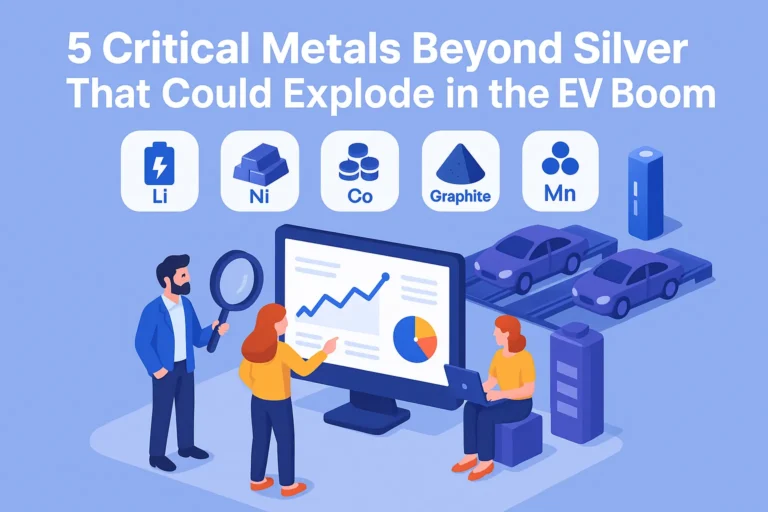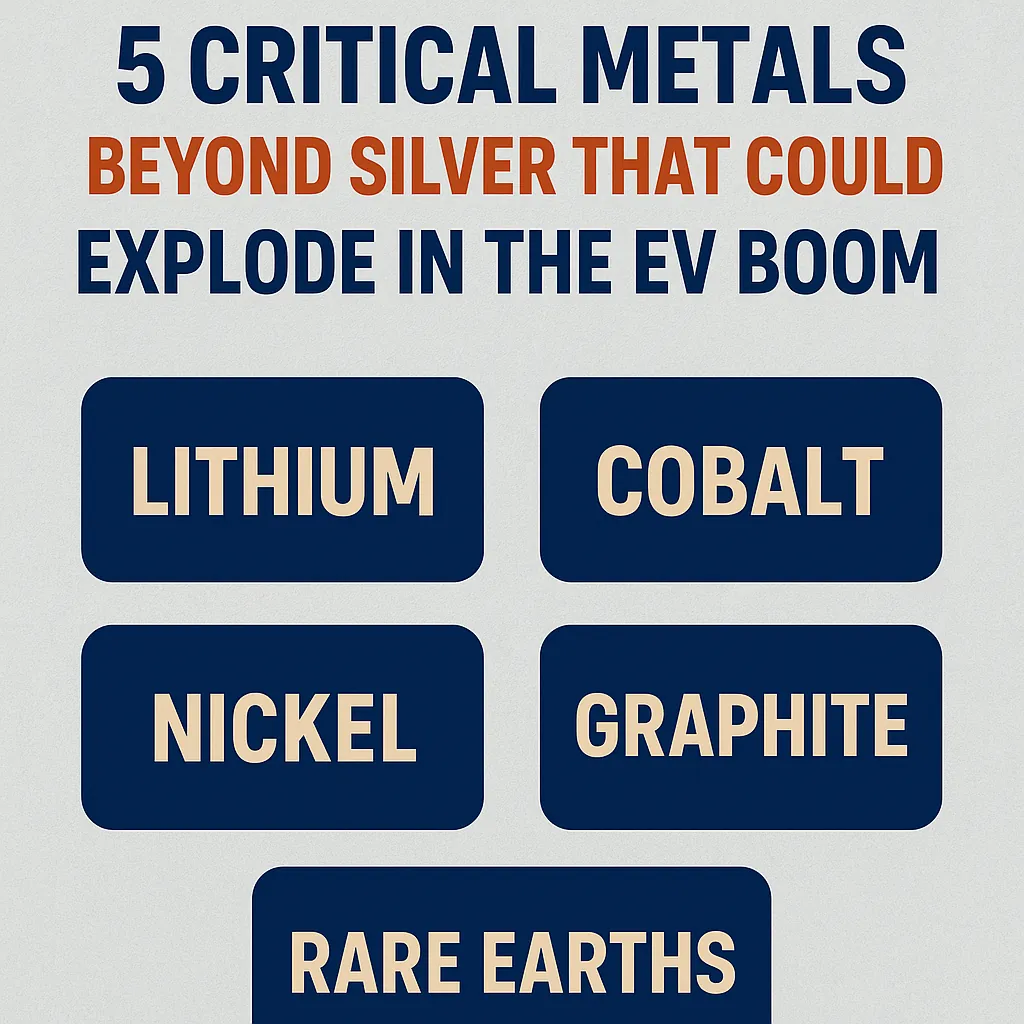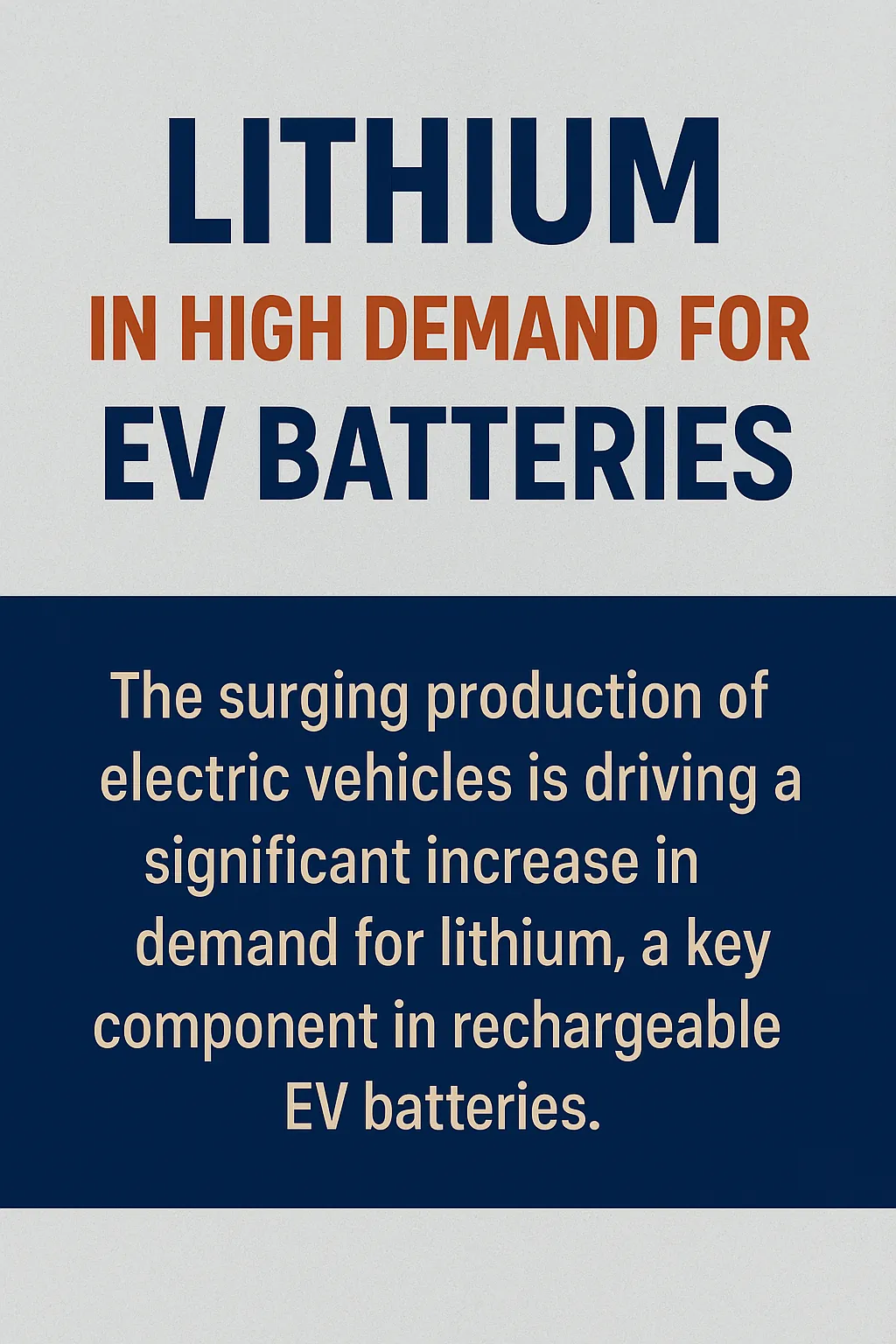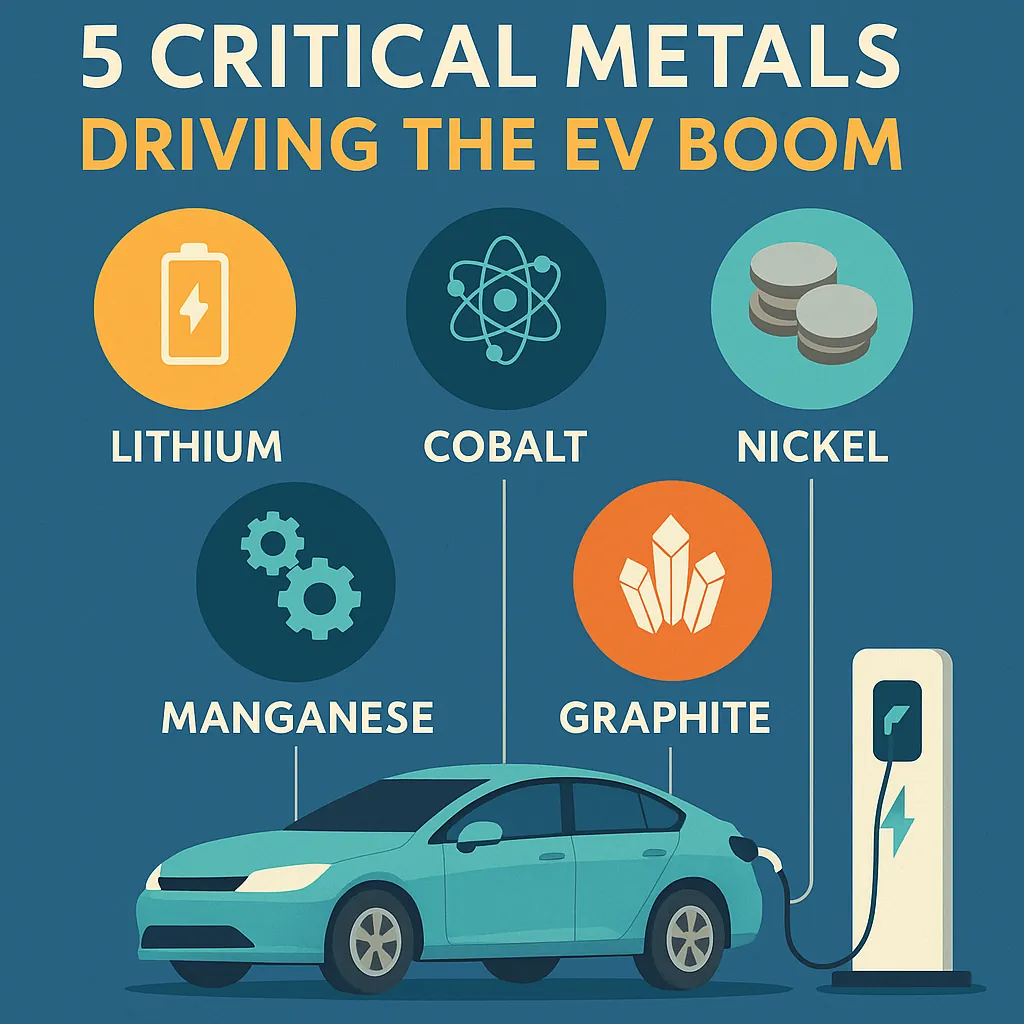
5 Critical Metals Beyond Silver That Could Explode in the EV Boom
Near-Future • EV & Clean Energy
If you’re mapping an EV-centric portfolio, critical metals investing deserves front-row attention. In this guide we break down five under-the-radar metals beyond silver—lithium, nickel, cobalt, graphite, and manganese—and show how each ties into battery chemistries, cell cost curves, and supply-chain risks. You’ll also see how themes like lithium stock opportunities, a nickel market forecast, and a realistic cobalt investing strategy fit inside a diversified plan for metals for EV demand and long-run exposure to clean energy metals stocks.
🔎 Quick Summary — What You’ll Get (and How to Use It)
- The 5 metals that matter now: Why lithium, nickel, cobalt, graphite, and manganese sit at the heart of EV batteries—plus where substitution risk lurks.
- Fast research framework: A 60-second checklist for screening miners, refiners, and ETFs across clean energy metals stocks.
- Position sizing & risk: Volatility rules, jurisdiction risk, and how to avoid single-asset blowups when pursuing critical metals investing.
Transparency Promise: This analysis is educational market commentary, not investment advice. We’ll link to authoritative research and highlight key risks (price cycles, refining chokepoints, policy changes). Always perform your own due diligence before acting on any critical metals investing theme.
New to building themes around commodities? Review our primers: Silver Market Forecast 2026, Fundamentals of Stock Market Investing, and Find Winning Stocks Using a Stock Screener.
⚡ EV Demand & Battery Basics (Why Metals Drive Margins)
The single largest force behind critical metals investing is the accelerating shift to electric vehicles (EVs). By 2030, BloombergNEF projects EVs could make up more than half of global passenger car sales, requiring exponential growth in battery production. Each EV battery contains dozens of kilograms of metals for EV demand, including lithium, nickel, cobalt, manganese, and graphite. That means the global race to secure clean energy metals stocks is not just about climate pledges—it’s about controlling the future of mobility.
Batteries are built around three pillars:
- Cathode: Energy density metals (lithium, nickel, cobalt, manganese).
- Anode: Primarily graphite, with silicon blends emerging.
- Electrolyte: Lithium salts, which enable ion transport.
Understanding these chemistries helps investors make sense of why some lithium stock opportunities surged early, and why new supply-demand imbalances are shifting toward nickel and manganese.
🔋 Metal #1 — Lithium (Chemistry Kingmaker & Price Cycles)
Lithium has been called the “white gold” of the EV boom, but experienced investors know it’s cyclical. In the last decade, lithium prices have spiked during demand surges, only to correct sharply as new mines came online. For critical metals investing, the key is recognizing these cycles and positioning accordingly.
Lithium stock opportunities exist across three verticals:
- Producers: Established miners like Albemarle and SQM, which scale supply quickly.
- Developers: Junior companies with projects in Argentina, Chile, and Australia, though risk is high.
- Refiners: Chinese converters dominate refining, creating bottleneck exposure for investors.
Analysts expect demand for lithium carbonate equivalent (LCE) to triple by 2030. However, supply bottlenecks—especially in refining capacity—mean volatility is inevitable. That volatility, paradoxically, is what keeps lithium stocks attractive for active traders.

⚖️ Competitor Review: Lithium vs. Other Critical Metals Lists
Several best penny stocks sites and commodity-focused newsletters highlight lithium as their #1 pick for the EV boom. But in our comparisons, many of these services ignore refining chokepoints and substitution risks. In contrast, a balanced critical metals investing strategy weighs lithium against nickel, manganese, and even non-battery plays like copper.
Want more on commodity cycles? See Gold Price Forecast 2026 for how similar boom-and-bust cycles shape metals investing, and review Silver Rally Trading Strategy for parallels in volatility management.
⚙️ Looking to capture early lithium stock opportunities? Track our curated watchlists and alerts to see how these plays compare against broader clean energy metals stocks.
View Our Metals Watchlist →🪙 Metal #2 — Nickel (Energy Density, Cost & Class 1 Supply)
When investors explore critical metals investing, nickel often gets overlooked—but it shouldn’t. High-nickel chemistries (NMC, NCA) are prized for their high energy density, which directly translates to longer driving ranges for EVs. However, not all nickel is created equal. Only Class 1 nickel, with purity above 99.8%, is suitable for batteries. This creates a significant supply challenge, since most nickel mined globally is Class 2, used for stainless steel.
A realistic nickel market forecast points to:
- 🔼 Rising demand for Class 1 nickel in EVs, particularly in North America and Europe.
- 🔼 Indonesia’s expansion in HPAL projects (high-pressure acid leach) aimed at battery-grade nickel.
- 🔽 Cost inflation risks from complex refining processes and environmental regulations.
Investors tracking metals for EV demand should note that nickel’s strategic value lies in balancing performance against cost. As cathode chemistries evolve, nickel remains essential, though its share may shrink if manganese-rich alternatives scale.
🔷 Metal #3 — Cobalt (Safety Benefits vs. Substitution Risk)
Cobalt has long been criticized for supply chain risks, but its safety role is undeniable. Cobalt stabilizes cathodes, preventing overheating and fires. This makes it vital for EV batteries—at least for now. Yet substitution trends (high-nickel, low-cobalt chemistries and LFP batteries) are gradually reducing its share.
A sound cobalt investing strategy balances these factors:
- 🌍 Geopolitical risk: Over 70% of cobalt supply originates from the Democratic Republic of Congo, a high-risk jurisdiction.
- ⚙️ Substitution trend: Automakers are shifting toward reduced-cobalt formulas, lowering long-term demand growth.
- 💡 Short-term upside: Cobalt remains essential for high-energy-density EVs and consumer electronics.
For critical metals investing, cobalt is not a “forever metal” but remains highly relevant in the 2020s. Its price will remain volatile, swinging with both EV demand and policy pressures around ethical sourcing.

Strengthen your strategy with our guides: 7 Market Trends Shaping 2026 Trading, Stock Market Predictions 2026, and Best Stocks to Invest: Analyst Comparisons.
For background, see IEA: Role of Critical Minerals in Clean Energy and S&P Global Nickel Market Forecast.
🚀 Ready to position for the EV supply chain? Track curated alerts on nickel market forecast and cobalt investing strategy to stay ahead of volatility.
Get Real-Time Metals Alerts →✏️ Metal #4 — Graphite (The Anode Workhorse: Natural vs. Synthetic)
While headlines obsess over cathode metals, the anode quietly soaks up the bulk of every EV battery by weight—and that anode is still mostly graphite. For critical metals investing, graphite represents a distinct, under-covered pathway to benefit from metals for EV demand. Investors should understand the differences between natural flake and synthetic graphite, and how purification and shaping costs drive margins.
- Natural vs. Synthetic: Natural flake is mined and then purified/spheroidized; synthetic is produced from petroleum needle coke at high temperatures. Synthetic boasts consistency but with higher energy/CO2 footprints.
- Purification chokepoint: A handful of Asian processors dominate high-purity anode material. This creates refining risk similar to lithium’s converter bottleneck.
- Substitution watch: Silicon-blended anodes are rising, but today’s mass-market cells still rely primarily on graphite.
Practical screening tips for clean energy metals stocks in graphite:
- Check where the project sits on the cost curve after purification and shaping—raw ore grades alone don’t tell the story.
- Prioritize offtake agreements with battery/auto OEMs; without offtake, financing risk remains high.
- Favor projects in jurisdictions aligned with target end markets to reduce tariff and logistics risk.
For portfolio construction, graphite can diversify exposure away from lithium price cycles while still tying directly into EV unit growth. It’s a complementary leg within a broader critical metals investing basket.
Keep building your commodity playbook with Silver Market Forecast 2026 and Find Winning Stocks Using a Stock Screener. Both pieces reinforce disciplined screening and entry planning for volatile themes.
Background: USGS: Graphite commodity summary and IEA: Critical Minerals Outlook.
🟣 Metal #5 — Manganese (High-Manganese Cathodes on the Horizon)
Manganese rarely tops investor wishlists, but high-manganese cathodes aim to bridge the gap between low-cost LFP and high-performance nickel chemistries. If these cathodes scale, manganese demand could surprise to the upside—precisely the kind of asymmetry that makes critical metals investing compelling.
- Chemistry thesis: High-Mn cathodes target better energy density than LFP with less reliance on cobalt and Class-1 nickel.
- Processing reality: Battery-grade manganese sulfate (HPMSM) capacity—not raw ore—will be the gating factor. Follow conversion projects, not just mines.
- Policy tailwinds: Regionalization of supply chains (North America/EU) could incentivize domestic HPMSM plants, shifting value capture away from raw ore exporters.
How to position within metals for EV demand:
- Screen for companies advancing HPMSM capacity with transparent capex, permitting, and commissioning timelines.
- Favor diversified producers or royalty/streaming models to blunt single-asset risk.
- Map customer proximity (cell plants, cathode facilities) to reduce logistics and working-capital drag.

Where silver fits alongside battery metals in EV supply chains.
Stock Market Predictions 2026Macro scenarios that can swing metals cycles and capex plans.
Trusted Trading PlatformsExecution tools for volatile commodity and microcap names.
Reference notes: USGS: Manganese commodity summary, Benchmark Minerals (battery supply data).
📈 Build a balanced basket across lithium, nickel, cobalt, graphite, and manganese. Track our alerts and screeners for clean energy metals stocks aligned with the EV build-out.
See Our Metals Watchlist →🌍 Supply Chains, Refining Bottlenecks & Jurisdiction Risk
A recurring theme in critical metals investing is that mining alone doesn’t capture the value—refining does. Lithium is dominated by Chinese converters, cobalt is tied to the DRC, and graphite anode material is refined by a handful of processors. This means investors must track not just ore deposits but also midstream processing capacity and political risk.
💼 How to Invest: Producers, Developers, ETFs & Royalty Models
Investors can capture metals for EV demand through several avenues:
- Producers: Established miners with steady cash flow.
- Developers: Higher risk/reward juniors advancing projects.
- ETFs: Diversified exposure across multiple clean energy metals stocks.
- Royalty/Streaming: Leverage to upside without operational risk.
📊 Portfolio Rules: Sizing, Rebalancing & Hedging Volatility
The volatility of critical metals investing makes discipline essential. Cap exposure per metal, rebalance quarterly, and use hedges (such as options or correlated ETFs) to reduce drawdowns.
❓ Frequently Asked Questions
1. Which critical metal has the highest EV upside?
Lithium remains the backbone of EV batteries, but graphite is equally essential by weight. Nickel and manganese may surprise investors as new chemistries scale.
2. How do I reduce geopolitical risk in cobalt?
Favor diversified producers, ETFs, or royalty companies instead of pure DRC-exposed juniors. A cautious cobalt investing strategy is critical.
3. Are lithium stocks still a buy?
Yes, but treat them as cyclical. Lithium stock opportunities are strongest when sentiment is washed out and demand trends remain intact.
4. Will recycling reduce demand for new supply?
Eventually, yes—but large-scale recycling won’t dent new demand until the 2030s. Near-term, fresh mining and refining remain essential.
5. Should I focus on ETFs or individual stocks?
ETFs provide diversified exposure across clean energy metals stocks, while individual names offer higher risk/reward. Many investors mix both approaches.
🏁 Final Verdict
The EV boom is not just about lithium and silver—it’s a multi-metal story. A well-rounded critical metals investing strategy spans lithium, nickel, cobalt, graphite, and manganese. Each metal carries unique catalysts, substitution risks, and supply-chain chokepoints.
For traders and long-term investors alike, the path forward lies in balancing exposure across these metals, tracking midstream refining capacity, and anticipating policy shifts. The winners will be those who look beyond headlines and focus on fundamentals.
📢 Stay ahead of the EV supply chain boom. Explore our Penny Stocks Watch List and alerts for opportunities in clean energy metals stocks.
Try TradeStockAlerts Today →